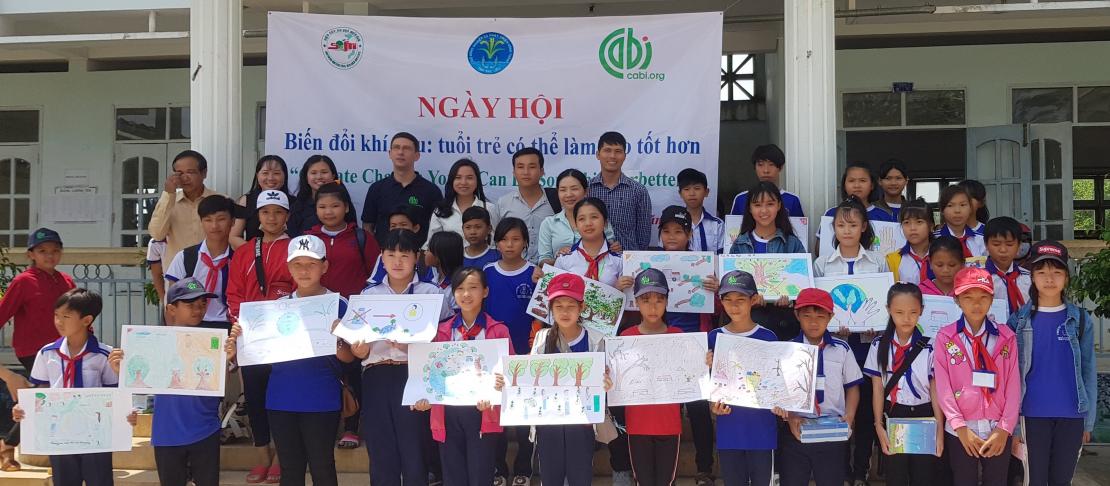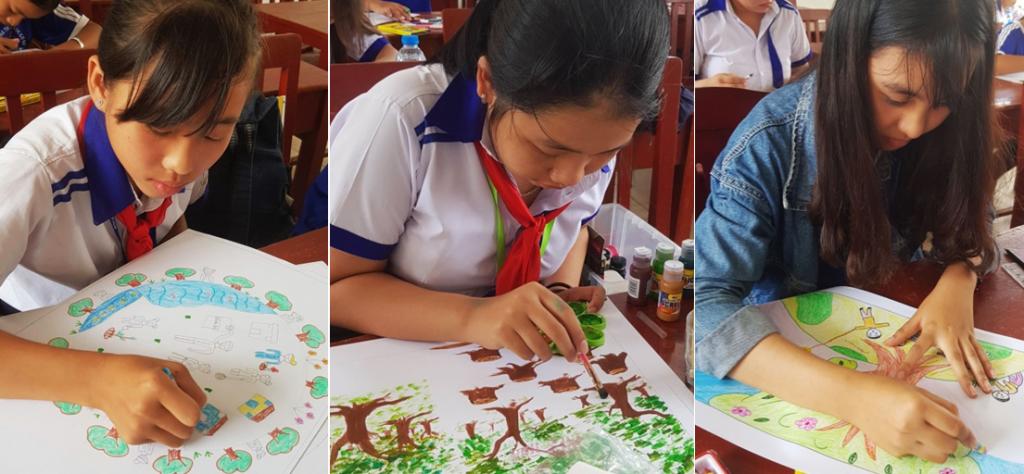Exploring the “art” in “climate-smart”

Art has a place in climate discussions. Children, who are usually deemed too young to understand complex topics such as climate change must be involved as well.
A campaign with the theme “Climate Change: Youth Can Do Something” was organized on 7 October 2018 in Tra Hat Climate-Smart Village (CSV) in Vietnam by the CGIAR Research Program on Climate Change, Agriculture and Food Security in Southeast Asia (CCAFS SEA) to enhance the youth sector’s understanding of climate change issues and enable them to visualize their learnings through their own drawings.
This event was part of the Pest-Smart program, a CCAFS SEA-led initiative that features innovative practices to restore agro-ecosystem health and manage pests and diseases in the three CSVs in Southeast Asia. The program includes women and the youth sector in order to develop gender-sensitive and socially-inclusive climate-smart technologies and practices. For this campaign, it aimed to engage the youth and tap into their creative skills, especially in visual arts, to reach more farmers in the CSVs.
The campaign was launched in Chau Thoi Secondary School and was attended by 52 students, a total of 19 teachers and parents, together with plant doctors and the local youth union. The participation of the youth union confirmed the growing interest of villagers in the Tra Hat CSV about climate change issues. This ‘citizen science’ approach, which refers to a collaborative research endeavour between experts and non-experts, identified location-specific climate challenges that the farmers face every day.
Several photos, a thousand words
Ms. Chau Kim Ngan, the head of the plant clinic in Tra Hat CSV, started the day with a presentation on climate change and agriculture. The presentation aimed to enhance the current knowledge of the students on climate change. The students were encouraged to ask questions to enrich their knowledge on the two interconnected issues.
 The students creating on-the-spot drawings during the art contest. Photo: H.T. Chan (CABI)
The students creating on-the-spot drawings during the art contest. Photo: H.T. Chan (CABI)
Afterwards, Dr. Arnaud Costa from the Center for Agriculture and Bioscience International (CABI) discussed climate change and pest-smart practices. Through several photos, Dr. Costa showed the grave impacts of climate change and indicated the need and urgency to address its impacts by adopting climate-smart agriculture (CSA) initiatives such as pest-smart practices. He emphasized that even the smallest actions could catalyze long-term changes in their environment.
Introducing another innovative presentation, Ms. Chan Hong Twu showed two short videos and animations on climate change to the students. After watching the videos, the students took a short quiz to assess what they learned.
Climate change illustrated
A panel of judges from CABI, school teachers and the youth union selected the five best drawings from the age-based categories. During the initial selection, the judges praised the enthusiasm, talent and creativity of the students that were reflected on their drawings. They were especially impressed by the students in the older categories.
The winners were eventually announced and received prizes from the organizers. Their drawings were displayed on the school’s announcement board as a recongition and also to encourage more students to use their creativity in exhibiting their learnings in the classroom.
Read more:
- News update: “Outsmarting” pests and diseases on farms
- Blog: Women farmers in Ekxang Village equipped with pest-smart practices against pests and diseases outbreaks
- Blog: Pest Smart interventions: Paving the way to pest and disease resilient rice farms
Dr. Chan Hong Twu is a Scientist at the Center for Agriculture and Bioscience International Southeast Asia based in Selangor, Malaysia.



